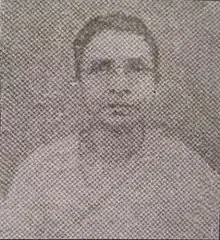Suniti Choudhury
Suniti Choudhury (22 May 1917 – 12 January 1988) was an Indian nationalist who, along with Santi Ghose, assassinated a British district magistrate when she was 14 years old[1][2][3] and is known for her participation in an armed revolutionary struggle.[2][4][5]
Suniti Choudhury | |
|---|---|
 Suniti Choudhury | |
| Born | 22 May 1917 |
| Died | 12 January 1988 (aged 70) |
| Known for | Assassinating a British magistrate at age 14 |
| Movement | Indian independence movement |
Early life
Suniti Chowdhury was born on 22 May 1917 in Comilla of Comilla District of Bengal (present Bangladesh) to Umacharan Choudhury and Surasundari Choudhury.[6] She was a student of Foyjunessa Balika Vidyalay of Comilla.[7][8]
Revolutionary activities
Chowdhury was influenced by the revolutionary activities of Ullaskar Dutta, who also lived in Comilla. She was recruited to the Jugantar Party by Prafullanalini Brahma, another pupil.[9] She was also the member of Tripura Zilla Chhatri Sangha. Chowdhury was selected as the Captain of the Women's Volunteer Corps in the Annual Conference of Tripura Zilla Chhatri Sangha, held on 6 May 1931.[10] During this time, she was known by the alias of 'Meera Devi'. She was selected as the “custodian of firearms” and was in charge of training female members (of the Chhatri Sangha) in lathi, sword and dagger play.[11][6]
Assassination of Charles Stevens
On 14 December 1931, Chowdhury, then 14, and Santi Ghose, who was 15, walked into the office of Charles Geoffrey Buckland Stevens, a British bureaucrat and the district magistrate of Comilla, under the pretense that they wanted to present a petition to arrange a swimming competition amongst their classmates.[2] While Stevens looked at the document, Ghose and Chowdhury removed automatic pistols which were hidden under their shawls and shot and killed him.[2][12][13]
Trial and sentence
The girls were taken into custody and imprisoned in the local British jail.[2] In February 1932, Ghose and Chowdhury appeared in court in Calcutta. Being a minor, both of them were sentenced to jail for 10 years.[14] In an interview, they stated, "It is better to die than live in a horse's stable."[14][5]
She was held captive in Hijli Detention Camp as a "third class prisoner".[15] The effects of her activities were also faced by her family, with her father’s government pension being stopped, and her two elder brothers being held in custody without trial. Her younger brother died from consumption, exacerbated by years of malnutrition.[7]
She was released with Santi Ghose in 1939, after having served seven years of her sentence, because of the amnesty negotiations between Mohandas Karamchand Gandhi and the government of British-occupied India.[7]
Public and media response
Contemporary Western periodicals portrayed the assassination as a sign of "Indians' outrage against an ordinance by the Earl of Willingdon that suppressed the civil rights of Indians, including that of free speech."[2] Indian sources characterized the assassination as Ghose and Chowdbury's response to the "misbehaviors of the British district magistrates" who had abused their positions of power to rape Indian women.[2]
After the verdict was announced, a flyer was found by the intelligence branch of police in the Rajshahi district praising Ghose and Chowdbury as nationalist heroines. The poster read, "THOU ART FREEDOM'S NOW, AND FAME'S" and displayed photographs of the two girls alongside lines from Robert Burns' poem Scots Wha Hae:[5]
"Tyrants fall in every foe!
Liberty's in every blow!"
Later life and death
After her release, Chowdhury studied and passed M.B.B.S. and became a doctor. In 1947, Chowdhury married Trade Union Leader Pradyot Kumar Ghosh.[7]
Chowdhury died on 12 January 1988.[7]
References
- Forbes, Geraldine Hancock (1997). Indian Women and the Freedom Movement: A Historian's Perspective. Research Centre for Women's Studies, S.N.D.T. Women's University.
- Smith, Bonnie G. (2008). The Oxford Encyclopedia of Women in World History. Oxford University Press, USA. pp. 377–8. ISBN 978-0-19-514890-9.
- Smith, Bonnie G. (2005). Women's History in Global Perspective. University of Illinois Press. ISBN 9780252072499.
- Kamala Das Gupta (January 2015). Swadhinata Sangrame Nari (Women in the Freedom Struggle), অগ্নিযুগ গ্রন্থমালা ৯. Kolkata: র্যাডিক্যাল ইম্প্রেশন. p. ১২০-১২৪. ISBN 978-81-85459-82-0.
- Guhathakurta, Meghna; Schendel, Willem van (2013-04-30). The Bangladesh Reader: History, Culture, Politics. Duke University Press. ISBN 978-0822353188.
- "826. Sudhin Kumar (1918-1984), 827. Suniti Choudhury, Ghosh (1917-1988)". radhikaranjan.blogspot.in. Retrieved 2017-11-23.
- Sengupta, Subodh; Basu, Anjali (2016). Sansad Bangali Charitavidhan (Bengali). 2. Kolkata: Sahitya Sansad. p. 445. ISBN 978-81-7955-135-6.
- Trailokyanath Chakravarty, Jele Trish Bachhar: Pak-Bharater Swadhinata Sangram, ধ্রুপদ সাহিত্যাঙ্গন, ঢাকা, ঢাকা বইমেলা ২০০৪, পৃষ্ঠা ১৮২।
- Rajesh, K. Guru. Sarfarosh: A Naadi Exposition of the Lives of Indian Revolutionaries. Notion Press. ISBN 9789352061730.
- Ghosh, Ratna (2006). Netaji Subhas Chandra Bose and Indian Freedom Struggle: Subhas Chandra Bose : his ideas and vision. Deep & Deep. ISBN 9788176298438.
- "Mysterious girls". The Telegraph. Retrieved 2017-11-23.
- "INDIA: Bengal Pains". Time. 1931-12-28. ISSN 0040-781X. Retrieved 2017-11-23.
- "WOMEN KILL MAGISTRATE". Chronicle (Adelaide, SA : 1895 - 1954). 1931-12-17. p. 37. Retrieved 2017-11-23.
- "INDIA: I & My Government". Time. 1932-02-08. ISSN 0040-781X. Retrieved 2016-04-12.
- "দেশের প্রথম মহিলা জেল এখন আই আই টি'র গুদামঘর!". Ganashakti/Bengali. Retrieved 2017-11-22.